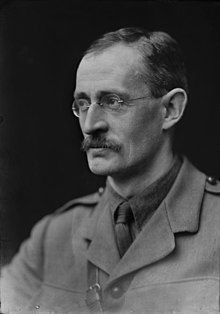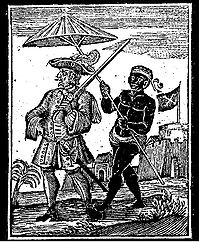Portal:Biography
The Biography Portal
A biography, or simply bio, is a detailed description of a person's life. It involves more than just basic facts like education, work, relationships, and death; it portrays a person's experience of these life events. Unlike a profile or curriculum vitae (résumé), a biography presents a subject's life story, highlighting various aspects of their life, including intimate details of experience, and may include an analysis of the subject's personality.
Biographical works are usually non-fiction, but fiction can also be used to portray a person's life. One in-depth form of biographical coverage is called legacy writing. Works in diverse media, from literature to film, form the genre known as biography.
An authorized biography is written with the permission, cooperation, and at times, participation of a subject or a subject's heirs. An autobiography is written by the person themselves, sometimes with the assistance of a collaborator or ghostwriter. (Full article...)
Featured biographies –
Constantine (Greek: Κωνσταντῖνος, 820s or 830s – before 836) was an infant prince of the Amorian dynasty who briefly ruled as co-emperor of the Byzantine Empire sometime in the 830s, alongside his father Theophilos. Most information about Constantine's short life and titular reign is unclear, although it is known that he was born sometime in the 820s or 830s and was installed as co-emperor soon after his birth. He died sometime before 836, possibly after falling into a palace cistern. (Full article...)
Big Star was an American rock band formed in Memphis, Tennessee in 1971 by Alex Chilton (vocals, guitar), Chris Bell (vocals, guitar), Jody Stephens (drums), and Andy Hummel (bass). They have been described as the "quintessential American power pop band", and "one of the most mythic and influential cult acts in all of rock & roll". In its first era, the band's musical style drew influence from 1960s pop acts such as the Beatles and the Byrds, producing a style that foreshadowed the alternative rock of the 1980s and 1990s. Before they broke up, Big Star created a "seminal body of work that never stopped inspiring succeeding generations" according to Rolling Stone. Three of Big Star's studio albums are included in the Rolling Stone list of the Top 500 Albums of All-Time.
Big Star's debut album, 1972's #1 Record, was met by enthusiastic reviews, but ineffective marketing by Stax Records and limited distribution stunted its commercial success. Frustration took its toll on band relations: Bell left not long after the first record's commercial progress stalled, and Hummel left to finish his college education after a second album, Radio City, was completed in December 1973. Like #1 Record, Radio City received excellent reviews, but label issues again thwarted sales—Columbia Records, which had assumed control of the Stax catalog, likewise effectively vetoed its distribution. (Full article...)
After Yazid died during the civil war, Zufar supported Abd Allah ibn al-Zubayr's bid to wrest the caliphate from the Umayyads, expelling the Umayyad governor of Qinnasrin, and dispatching Qaysi troops to back the pro-Zubayrid governor of Damascus, al-Dahhak ibn Qays al-Fihri. At the 684 Battle of Marj Rahit, the Qays were crushed by the Umayyads and their tribal allies from the Banu Kalb, rivals of the Qays, and al-Dahhak was slain. Afterward, Zufar set up headquarters in the Jaziran town of Qarqisiya (Circesium) and led the Qays against the Kalb, launching several raids against the latter in the Syrian Desert. By 688–689, he became embroiled in a conflict with the Taghlib tribe in support of his Qaysi ally Umayr ibn al-Hubab of the Banu Sulaym, despite previous efforts to mend their feud. After resisting three sieges of Qarqisiya from 685 to 691, Zufar negotiated a peace with the Umayyad caliph Abd al-Malik (r. 685–705). Zufar abandoned Ibn al-Zubayr's cause in return for privileges in the Umayyad court and army, as well as pardons and cash for his Qaysi partisans, who were integrated into the Umayyad military. The peace was sealed by the marriage of Zufar's daughter Rabab to the caliph's son Maslama. (Full article...)

Frederick Theodore Albert Delius CH (born Fritz Theodor Albert Delius; /ˈdiːliəs/; 29 January 1862 – 10 June 1934) was an English composer. Born in Bradford in the north of England to a prosperous mercantile family, he resisted attempts to recruit him to commerce. He was sent to Florida in the United States in 1884 to manage an orange plantation. He soon neglected his managerial duties, and in 1886 returned to Europe.
Having been influenced by African-American music during his short stay in Florida, he began composing. After a brief period of formal musical study in Germany beginning in 1886, he embarked on a full-time career as a composer in Paris and then in nearby Grez-sur-Loing, where he and his wife Jelka lived for the rest of their lives, except during the First World War. (Full article...)

Winfield Scott Hancock (February 14, 1824 – February 9, 1886) was a United States Army officer and the Democratic nominee for President of the United States in 1880. He served with distinction in the Army for four decades, including service in the Mexican–American War and as a Union general in the American Civil War. Known to his Army as "Hancock the Superb," he was noted in particular for his personal leadership at the Battle of Gettysburg in 1863. His military service continued after the Civil War, as Hancock participated in the military Reconstruction of the South and the U.S.'s western expansion and war with the Native Americans at the Western frontier. This concluded with the Medicine Lodge Treaty. From 1881 to 1885 he was president of the Aztec Club of 1847 for veteran officers of the Mexican-American War.
Hancock's reputation as a war hero at Gettysburg, combined with his status as a Unionist and supporter of states' rights, made him a potential presidential candidate. When the Democrats nominated him for president in 1880, he ran a strong campaign, but was narrowly defeated by Republican James A. Garfield. Hancock's last public service involved the oversight of President Ulysses S. Grant's funeral procession in 1885. (Full article...)
Uriel Sebree (February 20, 1848 – August 6, 1922) was a career officer in the United States Navy. He entered the Naval Academy during the Civil War and served until 1910, retiring as a rear admiral. He is best remembered for his two expeditions into the Arctic and for serving as acting governor of American Samoa. He was also commander-in-chief of the Pacific Fleet.
After graduating from the U.S. Naval Academy in 1867, Sebree was posted to a number of vessels before being assigned to a rescue mission to find the remaining crew of the missing Polaris expedition in the Navy's first mission to the Arctic. This attempt was only a partial success—the Polaris crew was rescued by a British ship rather than the US Navy—but this led to Sebree's selection eleven years later for a second expedition to the Arctic. That mission to rescue Adolphus Greely and the survivors of the Lady Franklin Bay expedition was a success. Sebree was subsequently appointed as the second acting governor of American Samoa. He served in this position for only a year before returning to the United States. In 1907, he was promoted to rear admiral and given command of the Pathfinder Expedition around the South American coast before being appointed commander of the 2nd Division of the Pacific Fleet and then commander-in-chief of the entire fleet. He retired in 1910 and died in Coronado, California, in 1922. Two geographical features in Alaska—Sebree Peak and Sebree Island—are named for Admiral Sebree. (Full article...)
Ernest Augustus (‹See Tfd›German: Ernst August; 5 June 1771 – 18 November 1851) was King of Hanover from 20 June 1837 until his death in 1851. As the fifth son of George III of the United Kingdom and Hanover, he initially seemed unlikely to become a monarch, but none of his elder brothers had a legitimate son. When his elder brother William IV, who ruled both kingdoms, died in 1837, his niece Victoria inherited the British throne under British succession law, while Ernest succeeded in Hanover under Salic law, which barred women from the succession, thus ending the personal union between Britain and Hanover that had begun in 1714.
Ernest was born in London but was sent to Hanover in his adolescence for his education and military training. While serving with Hanoverian forces near Tournai against Revolutionary France, he received a disfiguring facial wound. He was created Duke of Cumberland and Teviotdale in 1799. Although his mother, Queen Charlotte, disapproved of his marriage in 1815 to her twice-widowed niece, Frederica of Mecklenburg-Strelitz, it proved happy. The eldest son of George III, the Prince of Wales (later George IV), had one child, Charlotte, who was expected to become the British queen, but she died in 1817, giving Ernest some prospect of succeeding to the British and Hanoverian thrones. However, his elder brother Prince Edward, Duke of Kent and Strathearn, fathered the eventual British heir, Victoria, in 1819 shortly before the birth of Ernest's only child, George. (Full article...)

Sir William Beach Thomas, KBE (22 May 1868 – 12 May 1957) was a British author and journalist known for his work as a war correspondent and his writings about nature and country life.
Thomas was the son of a clergyman in Cambridgeshire. He was educated at Shrewsbury School and Christ Church, Oxford, before he embarked on a short-lived career as a schoolmaster. Finding that work unpleasant, he turned his attention to writing articles for newspapers and periodicals and began to write books. (Full article...)
Lieutenant General Sir Iven Giffard Mackay, KBE, CMG, DSO & Bar, VD (7 April 1882 – 30 September 1966) was a senior Australian Army officer who served in both world wars.
Mackay graduated from the University of Sydney in 1904 and taught physics there from 1910 until 1914, when he joined the Australian Imperial Force shortly after the outbreak of the First World War. He served with the 4th Infantry Battalion at Gallipoli, where he distinguished himself in hand-to-hand fighting at the Battle of Lone Pine. In April 1916, he assumed command of the 4th Infantry Battalion on the Western Front and led it at the Battle of Pozières, Battle of Bullecourt and Battle of Broodseinde. He was promoted to brigadier general in June 1918, and led the 1st Infantry Brigade at the Battle of Hazebrouck, the Battle of Amiens and in the attack on the Hindenburg Line. (Full article...)
Yasser Arafat (4 or 24 August 1929 – 11 November 2004), also popularly known by his kunya Abu Ammar, was a Palestinian political leader. He was chairman of the Palestine Liberation Organization (PLO) from 1969 to 2004 and president of the Palestinian National Authority (PNA) from 1994 to 2004. Ideologically an Arab nationalist and a socialist, Arafat was a founding member of the Fatah political party, which he led from 1959 until 2004.
Arafat was born to Palestinian parents in Cairo, Egypt, where he spent most of his youth. He studied at the University of King Fuad I. While a student, he embraced Arab nationalist and anti-Zionist ideas. Opposed to the 1948 creation of the State of Israel, he fought alongside the Muslim Brotherhood during the 1948 Arab–Israeli War. Following the defeat of Arab forces, Arafat returned to Cairo and served as president of the General Union of Palestinian Students from 1952 to 1956. (Full article...)











![Image 1 George IV Artist: Sir Thomas Lawrence An oil on canvas portrait of George IV of the United Kingdom as the Prince Regent, by Sir Thomas Lawrence. In 1814, Lord Stewart, who had been appointed ambassador in Vienna and was a previous client of Thomas Lawrence, wanted to commission a portrait by him of the Prince Regent. He arranged that Lawrence should be presented to the Prince Regent at a levée. Soon after, the Prince visited Lawrence at his studio in Russell Square. Lawrence wrote to his brother that: To crown this honour, [he] engag'd to sit to me at one today and after a successful sitting of two hours, has just left me and comes again tomorrow and the next day. More selected portraits](http://upload.wikimedia.org/wikipedia/commons/thumb/9/9f/George_IV_bust1.jpg/84px-George_IV_bust1.jpg)



































